#Hard science fiction
Text

Aphelion 3.0 is complete!
Head on over to the newly built turbofanatic.com to download it, plus the prior three comics, in .pdf form.
For those who don't know, Aphelion is my sci-fi webcomic, featuring hive minds attempting to combat an extraterrestrial threat, and one poor guy caught up in the war.
Be forewarned, there's a lot of body horror, violence, and the occasional bit of existential dread.
Let me know if you encounter any site issues!
#aphelion#comics#sci-fi#hard sci fi#hard science fiction#bio mechanical#bodyhorror#I can't believe it's finally done
287 notes
·
View notes
Text
New book announcement!
My new book, The Brightest Stars, is now available for preorder as an e-book on Amazon!
What's this book about, you ask? Well, here's the blurb:
Estelle’s life is pretty boring, all things considered: she doesn’t have much to worry about, she spends her days on archeological digs deep below the surface of Mars and writing scientific articles on the aliens who ruled over the Solar System many millennia ago.
But nothing lasts forever. Unexpectedly, Estelle and her mentor unearth long-lost knowledge which, if revealed, could dramatically shift the balance of power between nations, and possibly even turn the ongoing cold war between the major factions in the Solar System into a blazing hot one.
So now Estelle has to flee, leave her home behind in a bid to keep that knowledge from falling into the wrong hands; and along the way, she’ll have to decide where the lines of loyalty are drawn… and whom she can trust.
If I had to describe it really briefly, in one sentence: "Hard sci-fi spy thriller set in the twenty-fourth century."
Or maybe you'd like "Bond story from the point of view of the Bond Girl (who's a lesbian and asexual)."
Is your interest piqued? Then I have a clicky link for you right here 🙂
The release date is set for Saturday, July 20th, and it will be available as an e-book and as a paperback, and, in a first from me, it will be available to read on Kindle Unlimited!
I've put quite a bit of effort into writing this book, and I hope you'll like it ❤️
#my writing#trans#writers on tumblr#trans writers#tumblr writers#writerblr#transgender#fiction#novel#sci fi#hard science fiction
152 notes
·
View notes
Text
My mom bought me this book for Christmas
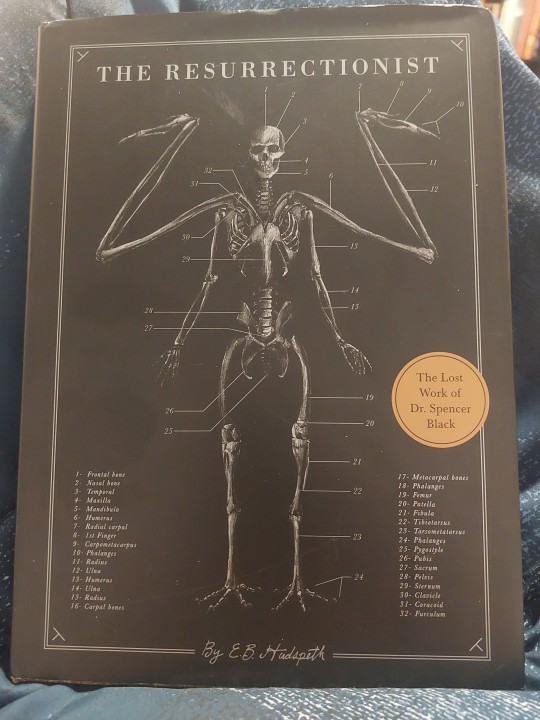
The Resurrectionist by EB Hudspeth, a fantasy field guide full of anatomical illustrations of monsters and cryptids.

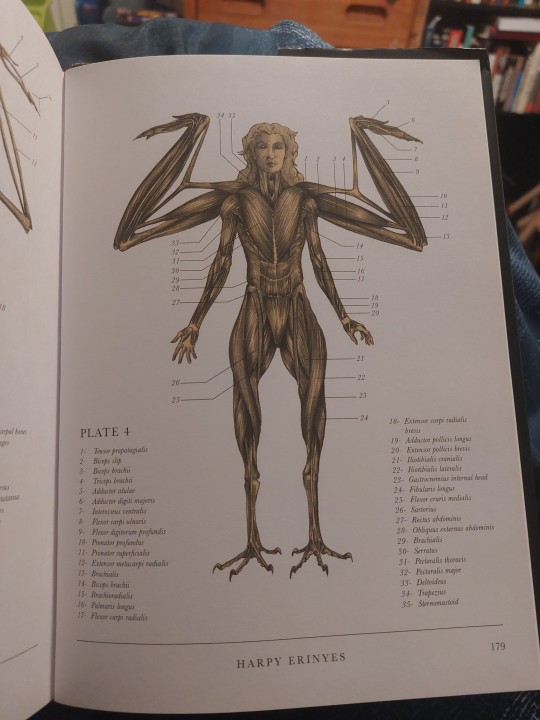
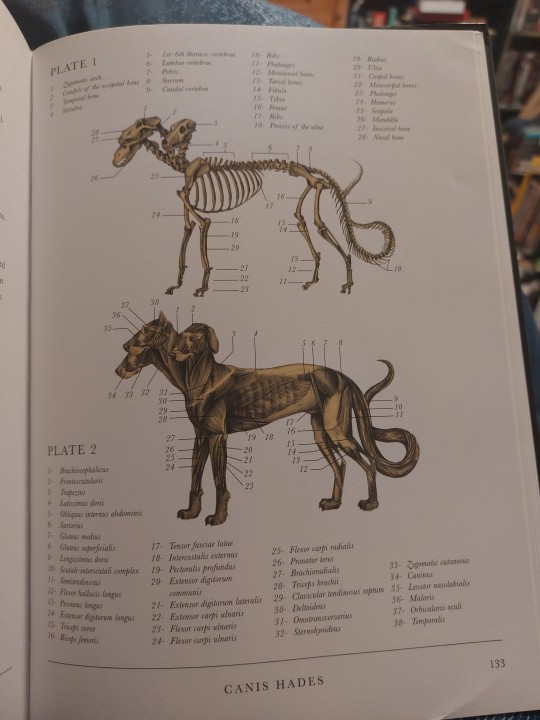

The musculoskeletal systems are fun to look at, but not nearly as in-depth as I would have liked. If you have more than a passing knowledge of taxonomy (or in my case, access to Wikipedia), a lot of the details fall apart under scrutiny
The harpy has four upper limbs connected to one shoulder girdle; it shouldn't have arms, only wings
The sphinx is not classified as a mammal, but is still somehow in the family Felidae with cats (and like the harpy is also drawn with only two girdles despite having six limbs. I will give the author credit for giving the sphinx a keel for the wing muscles to attach to)
It lists the Hindu deity Genesha as a cryptid, which is a no-no.
Cerberus is also explicitly not a mammal, but somehow still a canine (literally in the species Canis with wolves, dogs, and coyotes)
Both mermaids and dragons are listed as members of the order Caudata; the only extant members of Caudata are salamanders, which kinda makes sense for dragons, but not so much for mermaids (also, the author keeps playing it fast and loose with cladistics; both mermaids and dragons are in the same order despite being in different classes, and while dragons are explicitly said to be amphibians, mermaids are given the fictional class mammicthyes, which means mammal-fish. At that point, why not just call mermaids amphibians? Why make up a fake latin hybrid name?)
But what bugs me most of all is the classification of the Minotaur as its own order of mammal when in mythology it is explicitly described as a hybrid of two known species (made possible only by the cruel machinations of the divine, but still)
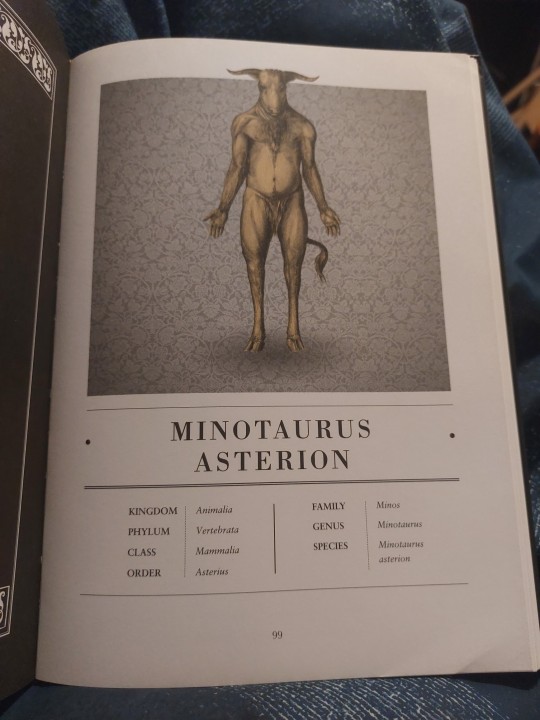
To use actual taxonomical nomenclature, the minotaur's species would be B. taurus × H. sapiens (specifically B. taurus♂ × H. sapiens♀; there are, to my knowledge, no legends of H. sapiens♂ × B. taurus♀). That's how ligers, tigons, mules, zorses, pizzly bears, narlugas, etc., are described.
If I had written this book, I would have leaned more into evolutionary biology. Most land animals have four limbs because they all evolved from boney lobe-finned fish, which split off from the boneless sharks and rays millions of years earlier, so any six-limbed vertebrates would need to be descended from a fictitious category of six-finned fish which would either be an offshoot of boney fish/tetrapods (I guess they'd be hexapods, though that term refers to insect arthropods), OR a precursor to boney and cartilaginous fish that both clades split away from much earlier (it's easier to lose structures than to gain them, so it makes more sense for a six-limbed ancestor to spawn four-limbed descendants than the other way around).
Think about how different elephants are from humans, and humans are from aligators, and aligators are from penguins, and remember that they all evolved from the same ancestor tiktaalik, an amphibious fish that existed some 375 million years ago. Imagine a precursor six-limbed species and how diverse all its descendants would look after 400 million years. Save for the occasional instance of convergent evolution causing two unrelated species to independently evolve similar body plans to fill the same niche, tetrapods and hexapods would look nothing alike. There would be very little recognizable overlap between the two. A six-limbed "pegasus" would not look like a real world horse, and a six-limbed "dragon" would not look reptilian/dinosaur-ish, for much the same reason that giraffes don't look like frogs; they're just too distantly related. Bonless sharks and boney fish and whales/dolphins all have similar looking bodyplans only because their environment requires the same hydrodynamic shape, while terrstrial vertebrates are much more physically diverse.
#biology#anatomy#monsters#cryptids#cryptozoology#book of monsters#evolution#evolutionary biology#evolutionary history#taxonomy#cladistics#science#hard fantasy#hard science fiction#hard science#tetrapod#hexapod
2K notes
·
View notes
Text
Don't shame people for writing or enjoying more grounded settings. People writing speculative fiction that cares about realism in certain aspects isn't stopping you from writing something that doesn't care about realism. "It's fantasy that shouldn't matter" isn't universal, if someone cares about that part of their worldbuilding you don't have a right to say they shouldn't. Just like how somebody talking agaisnt your world for being unrealistic in a place where you don't care about that level of realism sucks, it sucks an equal amount to dismiss someone striving for realism because you'd personally be fine with those aspects being unrealistic.
"Just let people enjoy things" applies to hard science fiction and low fantasy as much as it applies to soft science fiction and high fantasy.
#worldbuilding#writing#writeblr#writers on tumblr#fantasy#writers#196#writerscommunity#fantasy worldbuilding#worldbuilding advice#low fantasy#high fantasy#hard science fiction#hard sci fi#discourse#proship
502 notes
·
View notes
Text
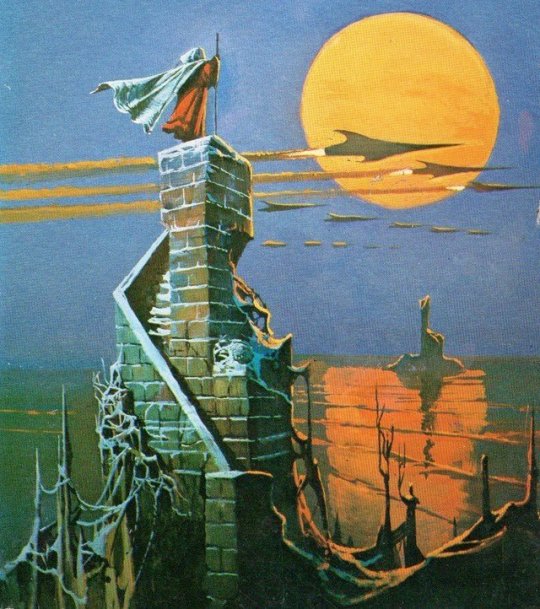
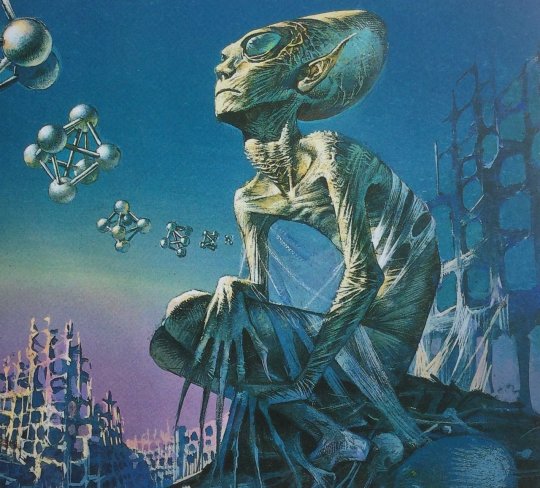


Bruce Pennington (1971, 1974, 1974, 1978)
#art#digital art#aesthetic#scifi#cyberpunk#science fiction#sci fi#scifiart#futuristic#scifi art#old art#old school#old scifi#retro scifi#retro science fiction#retro scifi art#alien planet#alien stage#alien aesthetic#alien planet art#hard sci fi#hard science fiction#spaceships#spaceship#70s sci fi art#70s science fiction#70s style#70s sci fi#70s science fiction art#old city
108 notes
·
View notes
Text
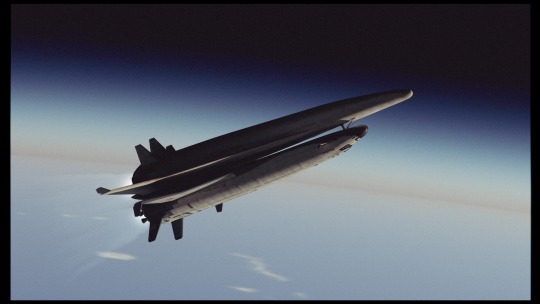

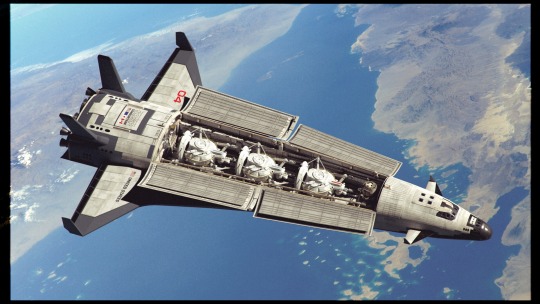
Pacifica Space Shuttle
By Mac Rebisz
134 notes
·
View notes
Text







Timothée Chalamet and Zendaya in Dune: Part Two (2024)
#my gifs#dune part two#denis villeneuve#timothée chalamet#zendaya#rebecca ferguson#javier bardem#dune part 2#dune movie#dune#dune 2021#dune 2024#action movies#scifi#hard science fiction#chani#paul atreides
95 notes
·
View notes
Text
if i had a nickel for every Andy Weir scifi novel im currently aware of which is not part of a series, has a cover depicting a man viewed through the visor of a spacesuit as he stares off into the distance, with the story itself pertaining to him being far from Earth seemingly with no hope of return-


104 notes
·
View notes
Text
It makes sense because of when they came out and the chain of inspiration--Macross and VOTOMS took from Gundam and Battletech took from Macross--but it's still kind of funny that Gundam has much more "Super Robot" design sensibilities than Macross, VOTOMS, and Battletech despite being much harder sci-fi.
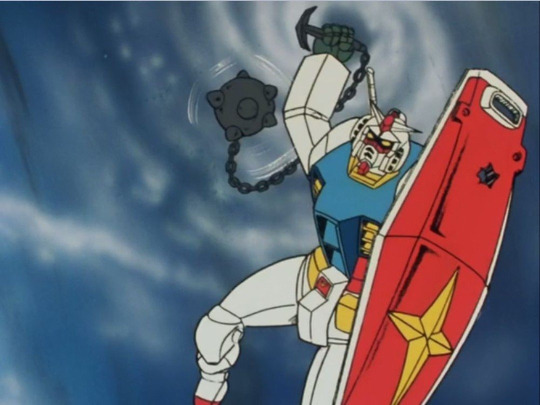

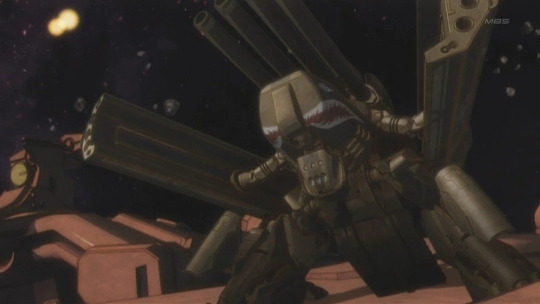

Gundam has mecha that look like high fantasy warriors and attack each other with melee weapons, spaceship designss that look straight out of Space Battleship Yamato, but it has no FTL, no artificial gravity, even travelling from the Earth to the Moon can take days, and travelling to the outer planets will take years.


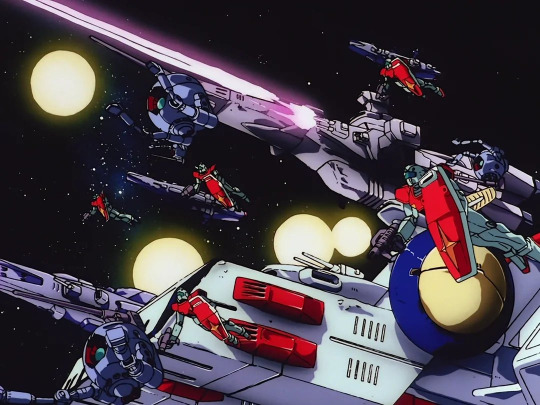
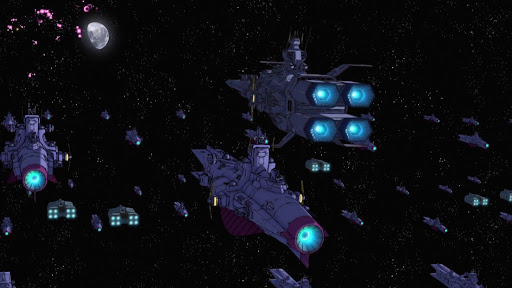
There's often a percieved dissonance between aesthetics and levels of realism in visual media sci-fi. Like, Star Wars looks more “grounded” than Star Trek, but commonplace tech in Wars is the domain of lost ancient civilizations in Trek.

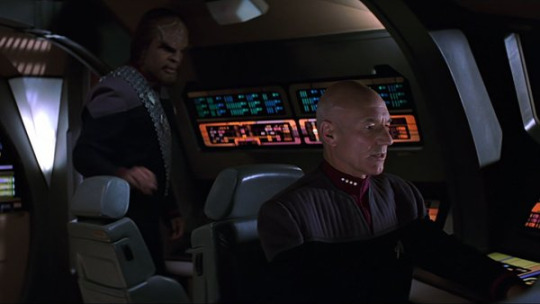

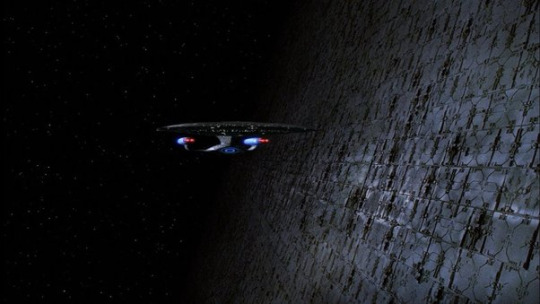
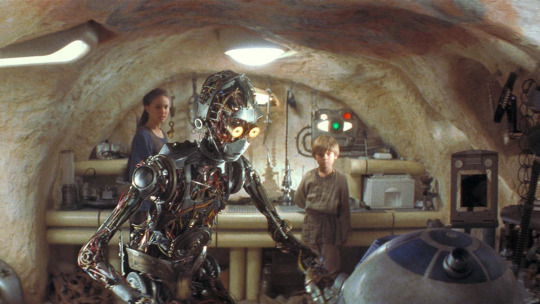
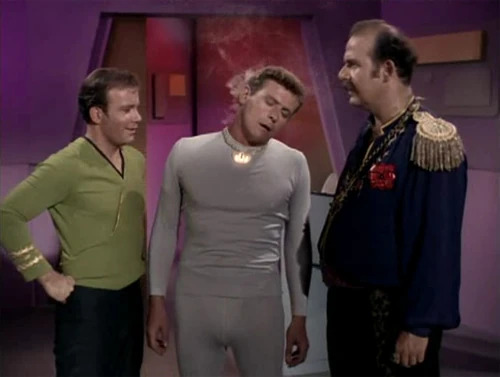
In its own way, Gundam is more realistic than The Expanse. There’s nothing in the Universal Century anywhere close to the raw power of the Epstein Drive.
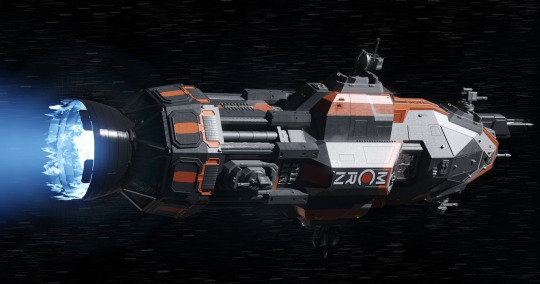
#gundam#mecha#super robot#real robot#aesthetics#science fiction#hard science fiction#star wars#star trek#the expanse#mobile suit gundam#armored trooper votoms#super dimension fortress macross#battletech#mechwarrior
36 notes
·
View notes
Text
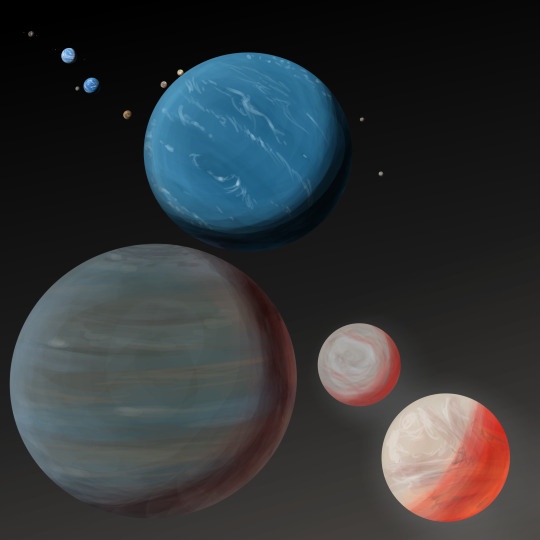


Losar System
Cooking the Solar System from the Inside Out
(yeah lol it does kinda look like it says Loser)
For this system layout, I have taken the Solar System planet's orbital distance in astronomical units, and taken the reciprocal.
The major planets, in order of increasing distance from Los, are Enutpen, Sunaru, Nrutas, Retipuj, Sram, Thrae, Sunev, and Yrucrem.
Read more about them below the cut:

The Losar system formed through a very different mechanism to our solar system. I'm not sure entirely about the specifics, but the arrangement is not dissimilar to the Kepler-90 system, in which 6 super-earth-mass planets are extremely compact and close to their parent star, with a low-mass and a high-mass gas giant at the outer part of the solar system. Perhaps as Retipuj formed, it migrated inward, carrying with it the ice and gas necessary to form the super-earth-mass planetary cores which accreted into Enutpen and Sunaru, or perhaps there was some kind of switcharoo where the Hot Ice Giants started out on more distant orbits, before crossing orbits with Retipuj and then being coralled into lower orbits.
Either way, some kind of migration is necessary, since Enutpen and Sunaru are volatile-rich, and the outer planets are comparatively volatile-poor.
I've excluded Pluto (or "Otulp") and the other dwarf planets, not because I don't like them or think they count as planets, but because I think by the time you're accounting for every large object in the Solar system in the Losar system, it just gets really implausible. also I bet some objects end up inside of the Sun. Plus, this kind of thought experiment is playing the same kind of planetary dynamics game that splitters are playing when they say Pluto's not a planet. Suffice to say, there are definitely lots of interesting small worlds in the Losar system, but they don't have 1:1 analogues with Solar system planets.
There are only five large moons in the entire system. Aside from Retipuj, satellites and rings are not stable around any of the Hot Giants. If satellites were initially formed around the Hot Giants, they would have either crashed into the planets or were ejected into one of the asteroid belts.
The first civilization to arise in the Losar system are the Sunevians, suspiciously great-ape-like feathered aliens who walk on their upper limbs and use their lower limbs as graspers. Sunev is an oceanic world with one large australia-sized landmass and a great number of volcanic islands. The ocean is relatively shallow, with a lot of coral reefs across the planet. The world is kept warm due to an atmosphere with an Earthlike composition but over twice the atmospheric pressure. Its slow retrograde rotation period results in day/night cycles which are more like seasons, and there is plenty of time during the warm nights to peek through the relatively dense cloud cover into the nearly empty sky. Early or late in the night, one might be able to see Thrae and Noom, or Sram, or if they catch it at just the right time, they might see the incredibly bright spectacle of Retipuj or even Nrutas peek out of the treeline, brighter than any planet or star. On a really good sunset across the ocean with clear skies, some observers report seeing additional super-bright red stars next to the red Sun, but these are thought to be some kind of weather phenomenon reflecting sunlight.
In rare moments of clear skies at night, away from light pollution, one might see many faint hazy spectacles. The zodiacal light (meteoroids orbiting beyond Yrucrem) shines as a faint haze across the ecliptic. The milky way too, shines as a glittery patchy cloud across the sky. But sometimes, every few hours, early in the night, there is a bright patch near the sun, brighter than the zodiacal light. A mystery for ages, but this is now known to be the cometary tail of Enutpen. Sunaru's tail is also detectable, but substantially fainter.
Sunaru and Enutpen were the first planets to be discovered, and were detected within a week of one another by early Losar observers. After the invention of the astronomical telescope, a reflector, observers got very bored during the daytime months. That is, until someone figured out a safe way of pointing towards the Sun. At a cadence of 52 and 103 hours, little black dots would march across the Losar disk. 52 hours was also the cadence of the brightening and dimming of the twilight zodiacal light. And suddenly, two brand new planets were discovered!
Millions of years later on the cold ice-age planet Thrae, astronomers would have an easier time with Enutpen and Sunaru, having known them to be planets since antiquity, due to their apparitions during total solar eclipses. Thrae's comparative cloudlessness also helps.
Sunev has three tiny asteroid moons, which was a helpful jumpstart to Sunevian space exploration, providing early wins for all four space programs. But these little asteroids were not truly other worlds, merely refueling outposts on the way to the rest of the Losar system.
Every few years, there would be a perfect alignment between Sunev and the Hot Giants to allow for a grand tour to be completed using only flybys of the gas giants, with minimal propellant expenditure. The first grand tour attempt got no further than Retipuj--contact was lost due to overheating before the probe made its Nrutas flyby. Specially developed solar flyby probes had to be developed that could survive hotter temperatures before the Hot Giants could be properly explored. These probes would resemble the Parker Solar Probe in some ways, albeit with very different scientific instruments designed for planetary science as opposed to Oilehphysics. Nrutas, Sunaru, and Enutpen turned out all to be much less massive than originally thought, having been puffed up to a larger diameter by being cooked by solar radiation. Nrutas, thought to be the king of the planets, turned out to be merely puffing up its crest to appear regal, so to speak.
Retipuj's moons were incredibly interesting. Retipuj turned out to have 8 satellites--four tiny inner asteroid moons, and four large satellite planets. Otsillac, the innermost turned out to be a volcanic world, yellow-brown in color and pitted with dull-red volcanoes, and a thin atmosphere constantly replenished by volcanic plumes. The next three are in a Ecalpal Resonance of 1:2:4. Being both larger than Otsillac (and, in fact, Yrucrem) and in a more eccentric orbit, Edymenag was even more volcanically active, with a molten surface and exposed mantle. The smaller and more distant Aporue and Oi turned out to be less active, with only a few active volcanoes and many extinct ones. Oi was the least active--although the most recent eruptions were only half a million years old, it was practically dead. It was also the only one with a substantial amount of impact craters, and like Thrae's satellite, Noom, there is likely some volatile ices stuck in the permanent darkness of polar craters.
Hot Giant exploration was best appreciated by specialists, but the other outer planets were much more appreciated. Sram was thought to be warm enough to potentially support liquid water, but its atmosphere ended up being 1/20th of the pressure initially expected, the majority of it having been blown away into space by the Losar winds and the Enutpen tail. But Thrae was a sweet spot--it may have had a thinner atmosphere, but that was compensated by being nearer to Los. In addition, a giant impact it sustained billions of years ago lead to it having a powerful magnetic dynamo to survive the onslaught of the Losar and Enutpen winds. Thrae was a habitable biosphere of similar complexity to Sunev's, albeit with deeper oceans and all the alien horrors that comes with the territory.
Even Yrucrem turned out to be a surprise--despite a dull appearance in telescopes, it was found to have cryovolcanoes and pockets of subsurface oceans, which could potentially support a biosphere. It's a dark brown color due to ice having been aged by solar radiation, with white spots and rays spraying out from recent asteroid impacts and cryovolcanic plumes. The small planets of the trans-Yrucrem asteroid belt were a similar treasure trove, although the nearest large trans-Yrucrem planets were a dozen au away, and requiring RTG power sources. Initial flyby probes to the Trans-Yrucrem-Objects required both being capable of surviving the oppressive heat of Los-shine near Retipuj, and the cold of deep deep space, in order to take advantage of Sunev-Thrae-Sunev-Retipuj gravity assists.
The Sunevians never had a chance to discover the deepest secrets of the Losar system. Their planet froze over due to anthropogenic aerosol production intended to reverse anthropogenic carbon emission, civilization fell, and it never recovered.
But millions of years later, perhaps the Thraelings have a chance to discover, whether through direct imaging or through analyzing the weirdly arrayed orbits of certain trans-yrucrem objects, the four Cold Giant planets, and the distant brown dwarf companion of the Losar system...
#Space#Planets#Long Post#Gas Giants#Ice Giants#Hot Jupiter#Hot Saturn#Puffy Jupiter#Solar System#Worldbuilding#Sci Art#Space Art#Planet#Moons#Moon#alternate universe#alternate history#speculative fiction#Science fiction#hard science fiction#digital art#astronomy#space exploration
81 notes
·
View notes
Text
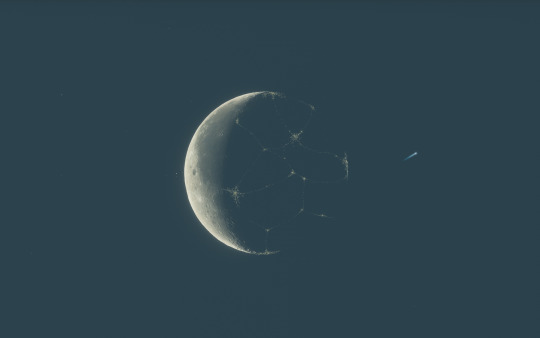
October 4, 2181: The UNSS Skyward Spirit ignites its massively powerful fusion drive in cislunar space, beginning its 24-year round trip to Proxima Centauri. Visible on the Moon are the cities of Byrd, Guǎnghángōng, Apollo City, Tsiolkovskiy, Tycho, and Shackleton, as well as many smaller settlements, all connected by the lunar rail system. Off the sunward limb of the Moon one can also spot the city-station Tsukuyomi in low orbit, with half a dozen vessels in its vicinity. Taken by an unknown photographer at dawn on the west bank of Lake Tanganyika (DRC), using a telescopic lens.
a rare Spy Art appears! photobash of the moment humankind started their very first journey to another sun in my hard science fiction setting Astra Planeta. edited in Paint.NET using a screenshot from Space Engine.
#Astra Planeta#spyglass’ realms#spy arts#worldbuilding#space#space art#futurism#future history#science fiction#hard science fiction#scifi#hard scifi#scifi art#scifi writing#photobash
38 notes
·
View notes
Text
My new book, The Brightest Stars, is out now!
That's right, it's finally here!!!
This book is a hard sci-fi spy thriller, basically a Bond novel from the point of view of the bond girl. Take a look at the cover!

What else is in this book? Well, we have...
Trans metaphors!

Suave spies putting the charms on people! (Or trying, to, at least.)

Sassy and touchy AIs!

Exciting action!

And much more!
Does this interest you? Well then, you can click the link right here to buy the e-book or paperback right away! 👇
(It's also available on Kindle Unlimited if you want 🤫)
Thank you for your attention, and I hope you enjoy reading my book!
#my writing#trans#writers on tumblr#trans writers#writerblr#tumblr writers#transgender#fiction#novel#hard science fiction#hard sci fi#science fiction#sci fi#spy thriller#new release
94 notes
·
View notes
Text
A CO₂ World: Honest Background Research in Worldbuilding
One of the most enduring—and fascinating—challenges of writing hard sci-fi is the fact that positing even very simple ideas often requires a great deal of background research, as I am not an expert in any of these fields. And not just any cover-your-ass research: honest research that attempts to portray physical truth.
Suppose a planet with an almost entirely carbon dioxide atmosphere. We actually have those in the Solar System: Venus and Mars. And suppose your spunky, left-handed, silver-haired starship captain is on the surface of such a planet (whose atmosphere is thankfully thicker than Mars' but not as thick as Venus'). Immediately, this raises numerous questions about the environmental description.
If she's not wearing protective gear, how does she breathe? This was the easiest to answer; I knew it would be a distributed nanite-scale system inside her body that liberated O₂ from the CO₂. All I had to do was study the most suitable means of achieving this, which ended up being nanite-scale electrolysis. A miniaturized of the same basic technology used on the Perseverance rover on Mars in its MOXIE instrument, actually. The high heats required are indeed alarming, but with the proper architecture it's not really a big problem to have tiny little nanovessels inside of you that are 1500 degrees. As for where the carbon goes, let's just say it is mostly exhaled and the rest causes blacker poos. (Which I say casually, but both of those claims also required research.) Problem solved, easy peasy lemon squeezy!
The color of the sky was an obvious question, though I didn't think of it till I was writing this, as I've done a lot of sky color research in the past and had kind of bypassed it this time due to starting with the blue color rather than starting with an atmospheric composition. I wanted blue, like Earth, for story reasons, but I was prepared to go where the facts led me if necessary. You're probably aware that the Martian and Venusian skies are not blue, but they also have their own other things going on. The Martian sky for instance is red mainly because of airborne rust dust. What about those blue Martian sunsets, though? That comes from the large size of the dust particles, and the associated light-scattering. So if our hypothetical planet has Earth-normal sizes of dusts in the air, it's not a problem—and since its atmosphere is similar in density to Earth's, this is a reasonable supposition. In any case, a purely carbon dioxide atmosphere doesn't necessarily impose any sky-color requirements. Or, rather, it does, but that requirement actually is blue, unless other things are going in the atmosphere.
There is very much an "unknown unknowns" danger when it comes to amateur research, and I am thankful for my lifetime of generalist curiosity, because it occurred to me yesterday to ask what carbon dioxide gas weighs. This would potentially affect the pitch of Cherry's voice. And, sure enough, pure CO₂ is moderately but noticeably heavier than Earth air, meaning a noticeably deeper voice but hardly that deep. I was quite pleased with myself, and relieved, to have thought of that.
But of course if one feather is plucked for the hat another might end up jabbing you in the butt. As I was going to bed last night, lights out, lying in bed, actively dozing off, it suddenly occurred to me that I hadn't thought about radiation! I knew that this hypothetical planet has a higher level of surface radiation from its parent star than we do and a reduced magnetosphere relative to Earth's. But how would this interact with a nearly-all-CO₂ atmosphere? Would Cherry actually be at risk to get a sunburn? I hadn't considered that until I practically dreamt it.
I remembered the question this morning and set about looking it up. Chemical absorptions of light are an endless minefield because I do not possess the scientific groundwork principles to deduce the answers to these questions. I always have to look them up. And usually I have to look them up with the end-use application in mind, rather than the question itself, due to the difficulty of getting good answers out of Google these days. But even helping Google along in this way is tricky, because unrelated conversations of a more popular nature (say, the effects of carbon dioxide on global warming) tend to dominate search results. This even happens at the human level: I found a Quora page where somebody asked the exact question I had, and several of the answers mistook it for a question about global warming.
Complicating the context of the question is that gases in the low atmosphere don't have the same function in this regard as gases in the high atmosphere. This was offset somewhat by the fact that I only needed to know what was happening on the surface—sunburn or no sunburn—and so it didn't actually matter which level of the atmosphere was blocking what. But finding an answer I could be confident about involved going through some of this. It is not a simple subject.
I answered to my satisfaction that there would still indeed be an ultraviolet radiation danger at the surface from a nearly-all-CO₂ atmosphere, especially in the UVA range. But then it occurred to me to ask about X-rays. On Earth we take it for granted that the electromagnetic spectrum below UV more or less doesn't exist in the ambient environment, but obviously that isn't a Universal given.
As time goes on, I am sure I will think of more questions. I always do. It really sets a contrast with the sort of sci-fi that just treats all this stuff as arbitrary and presumes to stave off factual questions with technobabble.
I do not mean this in a gatekeepy sort of way, but over the past years of working on Galaxy Federal I have come to see honest research as an inextricable part of the identity of science fiction storytelling. I think that by eschewing this one gives up some of their claim to the mantle of science fiction. It becomes more akin to fantasy at that point. Honest research is a necessary burden, sort of like hiking in the summer obligates one to sweat. But, unlike sweating, for me honest research is also quite a gratifying reward. I never feel as in-touch with the Universe, nor have so many run-ins with my old high school math and science education, as I do when I am researching my fiction. (The Curious Tale too, but that's just me being me and is an asterisk for another day. I guess in this sense you can think of The Curious Tale as being more sci-fi than fantasy; I have long conceived of it to myself that way.)
One of the most frustrating aspects of the challenge of honest background research is that either the Internet has become steadily less and less useful as an information-lookup service for these kinds of queries (from some combination of informative websites going offline and the degradation of search engine utility), or the means of information-lookup have changed such that they have become steadily less accessful to me. Whatever the causes, in my experience good information is getting harder and harder to come by. I find it distressing that my general queries are overwhelmingly funneled through Quora, StackExchange, and Reddit before delivering me with specific terminologies, numbers, and concepts that I can then google directly.
I was speaking not terribly long ago with someone who works at Google, and they were telling me about Google Search's changing philosophy over the years. I summed it up rather bitterly as: "They've destroyed the Second Great Library of Alexandria and replaced it with Ask Jeeves." And the Google employee more or less agreed.
That's sad, and it's also sad that more readers don't see sci-fi as an opportunity to learn about science. The decline of "hard" sci-fi in books and the near-total absence of it in TV and film productions speaks to the nature of (and subsequently reinforces) audience preferences. But not everyone lives in that demographic, and not everyone who does live there has to stay there. if I have an opportunity to introduce readers to (or remind them of) some of the scientific ideas that fascinate me, then, commensurate with my reward for doing the honest research of preparing them for the story, I hope there will be reflected the reward of reader enjoyment of these little amuse-bouches.
#Galaxy Federal#Worldbuilding#Hard science fiction#Carbon dioxide gas is colorless#But makes for some very colorful storytelling#The Curious Tale#No Cherries were sunburned in our research experiments.#And if they were you can't stop me.#Muah ha ha!#(In a slightly deeper voice.)
11 notes
·
View notes
Text
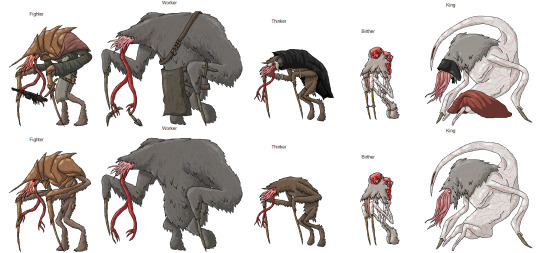
Thinking about this spec evo race I've had for a while. They're very much at the edge of my setting, but I still think they're interesting lil guys. They're aliens that travel by generational ship to set up colonies in other star systems. They're eusocial like bees or ants, but they're not a hive mind, that's just how they naturally reproduce, the workers, fighters and thinkers are all about as intelligent as a human, and the kings and breeders are basically their cattle. While they are intelligent, they don't have the same instincts for things like self-preservation that we do, so they'd gladly die for their hive.
There's a lot of politics between them, humans and two other species. Though since everything is slower than light its politics that are too big and slow for any single faction to really understand, almost like a futuristic version of how homo sapiens interacted with other human species.
What do you guys think of them?
#spec evo#speculative zoology#speculative fiction#speculative biology#speculative evolution#my art#worldbuilding#my worldbuilding#alien#alien species#alien civilization#hard science fiction#hard sci fi#science fiction#scifiart#spec evo art#eldrichcore#eldrich horror#eldritch#hive
83 notes
·
View notes
Text
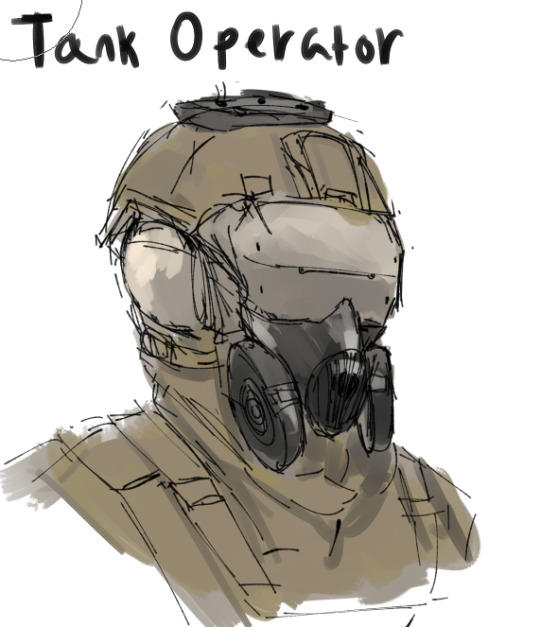


some quick design doodles for my personal TTRPG project
40 notes
·
View notes
Text




The Vonnegut
By Seth Pritchard
46 notes
·
View notes